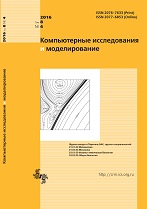|
This article is cited in 4 scientific papers (total in 4 papers)
MODELS IN PHYSICS AND TECHNOLOGY
New algorithms for composing differential equations of the motion of the exoskeleton with variable length of the links and the control of hinge-joint
A. V. Borisova, G. M. Rozenblatb
a The Branch of National Research University “Moscow Power Engineering Institute” in Smolensk,
1 Energeticheskiy proezd, Smolensk, 214013, Russia
b Moscow Automobile and Road Construction State Technical University,
64 Leningradsky prospect, Moscow, 125319, Russia
Abstract:
The article discusses the model of the anthropomorphic type of mechanism of the exoskeleton with links of variable length. Four models of parts of variable length are considered comprehensively: the model link of the exoskeleton of variable length with a resilient member and a rigid strong core; the model of the telescopic link; the model link with the masses in the hinge-joint between them; the link model with an arbitrary number of masses. The differential equations of motion in the form of Lagrange equations of the second kind are made. On the basis of analysis of differential equations of motion for multi-link rod of a mechanical system type, exoskeleton revealed their structure, which allowed us to represent them in vector-matrix form. The General pattern of building matrices are established for the first time and the generalization of the expressions for elements of matrices in two-dimensional case are obtained. New recursive and matrix methods of composing of differential equations of motion are given. A unified approach to constructing differential equations of motion of the exoskeleton based on the developed recursive and matrix methods write differential equations of motion of the proposed exoskeleton. Comparison of the time of writing the differential equations of motion proposed methods, in comparison with the Lagrange equations of the second kind, in the system of computer mathematics Mathematica conducted. An analytical study of the model of the exoskeleton carried out. It was found that for mechanisms with n movable links of the Cauchy problem for systems of differential equations of motion for any initial conditions there is no single and unlimited continue. Control of the exoskeleton is accomplished using the torques which are located in the hinge-joints in the joints of the links and simulating control actions. Numerical investigation of a model of the exoskeleton is made, a comparison of results of calculations for exoskeletons with various models of units is held. A numerical study of the empirical evidence about the man and his movements is used. It is established that the choice structure of the exoskeleton model with lumped masses is more preferable to a model with perfectly rigid strong core. As an exoskeleton, providing comfortable movement of people, and you should repeat the properties of the musculoskeletal system.
Keywords:
exoskeleton, link of variable-length, hinge-joint, control, differential equations of motion, recursion, matrix, method, the energy integral, numerical solution.
Received: 27.11.2016
Revised: 18.02.2017
Accepted: 20.02.2017
Citation:
A. V. Borisov, G. M. Rozenblat, “New algorithms for composing differential equations of the motion of the exoskeleton with variable length of the links and the control of hinge-joint”, Computer Research and Modeling, 9:2 (2017), 201–210
Linking options:
https://www.mathnet.ru/eng/crm58 https://www.mathnet.ru/eng/crm/v9/i2/p201
|

| Statistics & downloads: |
| Abstract page: | 260 | | Full-text PDF : | 104 | | References: | 42 |
|




 Contact us:
Contact us: Terms of Use
Terms of Use
 Registration to the website
Registration to the website Logotypes
Logotypes








 Citation in format
Citation in format 
